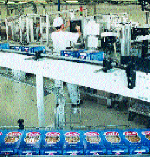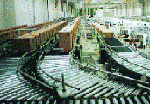

A steady program of new plant investment, improved technology and product development has made Barilla a major international player, as well as a clear leader in the areas of pasta, pasta sauces and bakery products in the Italian market. Barilla is the leader in worldwide pasta production and currently the third-largest bakery producer in Europe. In Italy, the company claims 35 percent of the dried pasta market, putting it well above its nearest rival, which has only 5 percent.
With pretax profits up by an impressive 42 percent -- to E139 million -- in 1999, the group is enjoying the results of a successful strategy adopted by the three Barilla brothers -- Paulo, Luca and Guido -- who own 85 percent of the company's profits. Barilla has made massive investments totaling almost E600 million in the past three years. In June 1999, new "twin" pasta plants were opened in Ames, Iowa, and Foggia, which is located in the south of Italy. Construction of a pasta factory in Greece is almost complete, and a plant was opened at Pedrignano in Parma to produce a new line of filled pasta. Barilla has also made improvements to existing facilities as part of its modernization program.
The entrepreneurial spirit of Barilla has been evident from the very beginning. The story begins in 1877, when Pietro Barilla opened a pasta and bread shop in Parma with a wooden press that produced 50 kg of pasta a day. The company's first factory was built in 1910, and Barilla continued expanding until 1970, when the family opened the largest pasta plant in the world in Parma -- a facility totaling 25 million square meters and capable of producing 1 million kg of pasta a day. In 1991, Barilla accelerated its internationalization with the purchase of Misko, the leading pasta producer i Greece. Subsequent acquisitions have strengthened Barilla's presence in the European market. Its latest acquisition, which occurred last year, was the Wasa group, a worldwide leader in crispbread production that has manufacturing plants in Sweden, Germany, Denmark, Norway and Poland.
Today, Barilla is Italy's leading food group with 22 production plants in Italy and four located abroad. It also manages seven mills that supply 70 percent of all the raw materials it needs. Providing some measure of the scale of production at its factories, Barilla annually uses some 1,150,000 tons of durum wheat, 350,000 tons of tender wheat and 500 million eggs -- produced by two million chickens.

New plant
One of the newest plants opened by Barilla is "Foggia 2" in the south of Italy. An existing factory -- "Foggia 1" -- acquired in 1975 and modernized in 1983, was already producing 70,000 tons of long and short pasta a year. Pasta-making equipment from both Swiss company Buhler and Italian company Fava are in operation at Foggia 1, producing a variety of pasta shapes that are packed into boxes or form-fill-seal clear packaging.Equipment from Sasib Ricciarelli is very much in evidence and includes the following: two multihead weighers (FCB15) with variable angle vertical baggers (one for short pasta and one for fragile products); a traditional weigher (FCN5000) with vertical bagger VSC for 5 kg short pasta packs; and, for long pasta, a special feeding system composed of three elevators with a double loader.
Selezione Ora, a specialty product for the restaurant trade, is produced at Foggia 1. This type of pasta can be cooked for 5 minutes and then, just before it is served, cooked for an additional 2 to 3 minutes. This convenient catering product is packaged into 5 kg or 1 kg packs on a Sasib packaging line. In the new Foggia 2 factory, two high-tech lines produce 100,000 tons of long and short pasta a year -- a remarkable feat, considering that the 70,000 tons produced at Foggia 1 require six lines. The new plant is believed to be the highest-capacity pasta production plant in the world.

Supplied by Buhler, Barilla's short pasta line has a capacity of 8,000 kg per hour. A series of mixers (above) mix water and semolina.
A TTHC Turbothermatik dryer line gradually dries the pasta before packaging. "The drying process is crucial to finished product quality," said Giovanni Palopoli, assistant director of production at Foggia. "At the beginning of the drying cycle, humidity is 38 percent and, at the end, 12 percent. The temperature/time ratio is strictly controlled, and regular samples are sent to the quality control department to ensure that only the best-quality pasta is produced." Because all goods, from raw material to the packaged product, are strictly controlled, less than 1 percent of product fails to meet the required standard.

Palopoli explained that the chief difference between the long and short pasta lines is that the short pasta does not need to be kept in order, while the long pasta (spaghetti) has to be hung over bars in a uniform manner and length during transport through the dryer.

Most of the product from the Foggia plants is destined for the Mediterranean area, as well as Africa, the Middle East and South America. Products such as egg pasta, which are not produced at Foggia, are also channeled through its warehouse for dispatch to these markets. A logistics specialist provides full distribution service for Barilla. Palopoli explained, "Our expertise is in production, so we prefer to let an outside company look after the logistics."
Products from this and other factories in the Barilla group are exported to more than 100 countries, with local agents active in many local markets. The company has subsidiaries throughout Europe and the U.S.; joint ventures in Brazil and Mexico; and alliances in Japan, South Africa and Poland.
Pasta is packaged in 1 kg or 500 g boxes for the Italian market, which Barilla dominates. After being placed in cartons, the product
is transported to warehouses.

Product innovation
Research and development is central to the success of the Barilla group, and in 1998, more than E40 million was invested in such activity. "Product innovation will continue to be one of the group's priorities," commented Guido Marial Barilla, president of the company.The brands under which the company markets its products are Voiello and Barilla (wheat pasta); Emiliane (egg pasta); Brailla (pasta sauces); Mulino Bianco and Pavesi (bread substitutes such as bread sticks and crackers, butter biscuits and pastries); Mulino Bianco (snacks and pies); Le Tre Marie (festivity products and croissants); Panem (fresh bread); and, more recently, Wasa.
The company's mission, in the words of the Barilla brothers, is "to contribute to people's health by offering high-quality and nutritionally balanced products." To achieve this goal, Barilla stays in touch with consumers to find out what products they require. "The basis of further growth will continue to be meticulous care in improving existing products and the development of foods that are increasingly in line with new lifestyles," Guido Barilla said.
Some of the newest products from Barilla illustrate perfectly how the company is staying in tune with its consumer needs. The most interesting new development is a range of dried filled pasta in two formats: tortellini (small pieces of about 2 g each) and tortelloni (pieces of about 4 to 5 g each), which is said to taste "as good as fresh-filled pasta." Produced at a new plant in Parma, the processing method used is a closely guarded secret, but Antonio Copercini, global operations director, said, "We have used a combination of technologies already present in the food industry, but nobody else is using them in quite the same way. Using different suppliers, we designed the line ourselves. The result is a product that compares well with fresh pasta, but which has a shelf life of six to eight months. The tortelloni, in particular, is difficult to produce in dried form, and is generally only available in fresh form."
The company conducted research among 22,000 consumers before launching this new product in Italy. It has since been launched in France and will be rolled out in the rest of Europe in the near future. The products take 10 to 12 minutes to cook.
Asked why Barilla does not produce any fresh pasta, Copercini replied, "A few years ago, we launched a range of fresh pasta. Although the quality of the products was excellent, we entered the market too late. A strategic decision was made by our CEO to discontinue the fresh products and to concentrate on our strong shelf-stable business, using the best technology available."
The new tortellini range has raw ham and cheese fillings, while the tortelloni range consists of meat, asparagus, mushroom, and ricotta and spinach varieties. It comes in reclosable packs that do not need refrigeration, even when opened. (The packaging line was supplied by Swiss company SIG, with case packers from Italian company OPM.) The 250 g pack is said to provide three portions.
In the bakery sector, Barilla has recently launched a new line of cakes in Italy under the Mulino Bianco brand. The line, which features eight different varieties, is said to have the aroma of freshly baked cakes. However, the industrial cake market is relatively small in Italy, and fresh cakes account for 74 percent of it. Packaged cakes are generally unbranded and seen as "standby" products, but Barilla hopes to revitalize this market with the new fresh-tasting cakes.
In the sauces sector, Barilla's most recent launch is a range of ready-made white sauces, which extends its existing portfolio of pasta sauces. The volume of pasta sauces in Italy was up 6.6 percent in 1999 from the previous year; and white sauce in particular grew by 10 percent.
The new sauces come in three varieties: tartufo & funghi (black truffles and mushrooms), salmone (made with north European salmon) and asparagi (asparagus). They are low in fat, and are characterised by a delicate, subtle taste.
People are important
Barilla's success in winning FEI's inaugural award is well-deserved. Its investments for the future in technology, marketing and product development show a commitment to growth through products that offer consumers convenience as well as quality.What is the secret of Barilla's success? In the words of Guido Barilla, "Actually, there is no recipe for success in Barilla, just an entrepreneurial culture based on two fundamental elements -- first, designing and producing high-quality products with the very best raw materials and advanced technology. And second, communicating with the public effectively and stylishly to explain and illustrate the qualitative, nutritional and gastronomic values of the products.
"What really binds these two elements together is human resources. As Pietro Barilla, for 50 years the driving force of the company, maintained, 'People prevail above all. Without them you can't even think about realizing a project, whatever it might be. Working with people -- specialists in every field -- projects become realities.' This is perhaps our only 'recipe.'"
